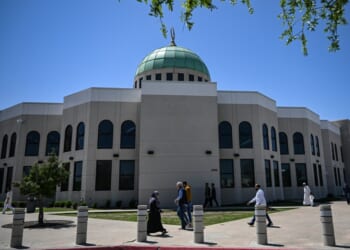Let’s take a look at Miles Taylor’s recent screed – masquerading as principled commentary –accusing President Donald Trump of a “blatantly unconstitutional” act by pressuring the Department of Justice to prosecute James Comey (“With the Comey indictment, Trump commits an impeachable offense; The criminal conduct is worse than his previous impeachments”). It is nothing short of intellectual malpractice.
Taylor, a self-styled whistleblower and CNN darling, peddles the tired trope that such executive direction of the attorney general violates some sacred “independence” of the Justice Department, warranting impeachment. This is hogwash, a fever dream of progressive jurisprudence (aka, judicial gibberish). It ignores the Constitution’s plain text and structure. As an unreconstructed originalist – a refugee from battling too many postmodern, language-mangled judicial interpretations – I see Taylor’s claim not just as misguided, but also as symptomatic of a deeper rot: the pernicious myth of judicial supremacy, birthed illegitimately by John Marshall in Marbury v. Madison (1803).
Taylor’s error provides the perfect excuse to expound my theory that the Constitution was deliberately crafted without a “stopping rule” – no final arbiter, no supreme interpreter – to ensure perpetual contestation among branches, fostering equilibrium through raw power politics, not robed fiat. Let’s dismantle Taylor’s folly step by step.
He asserts Trump’s pressure on the DOJ to indict Comey – an action rooted in the President’s Article II authority as chief executive to “take Care that the Laws be faithfully executed” – is an “extraordinary abuse of power.” Nonsense. The Constitution vests “the executive Power” solely in the President (Art. II, §1), empowering him to direct subordinates, including the attorney general, in enforcing laws. There’s no textual whisper of DOJ “independence;” that’s a post-Watergate fairy tale, not Framers’ intent.
If Trump believes Comey’s actions violated false-statement laws codified at 18 U.S.C. §1001(a)(2) and 18 U.S.C. § 1505, ordering prosecution is his duty, not a crime. Taylor’s impeachment-call reeks of partisan hysteria, conflating his dislike for Trump with violation of constitutional principles. But his real sin is assuming some external authority – implicitly the courts – gets to declare this presidential act “unconstitutional,” as if the judiciary holds the trump card. This betrays a profound misunderstanding: The Constitution has no stopping rule, no primus inter pares among branches.
Disputes among the branches weren’t to be resolved by judicial decree; they were to be battled out among the three branches until balance emerges. The Framers, scarred by monarchic tyranny and colonial overreach, designed a system of separated powers with intentional ambiguity on interpretation. Each branch – executive, legislative, judicial – interprets the Constitution independently in exercising its powers and duties. The President enforces laws as he reads them; Congress legislates within its viewed limits; courts resolve disputes under existing statutes and derivative regulations.
Disagreements? Conflict? Built right into the design of the Constitution, not an internal deficiency of the Constitution to be rectified by the courts. No “final-say” clause exists.
Instead, branches were meant to check each other: Congress impeaches or withholds funds; the President vetoes or refuses enforcement; courts… well, courts opine and rule in specific cases, perhaps enforcing its own interpretation of the laws and regulations at issue; but their words aren’t gospel for everyone else beyond the parties to the case. This back-and-forth is the genius: a dynamic equilibrium, akin to a market equilibrium, where preferences clash until supply meets demand. No branch gets its “most-preferred” outcome absolutely; each settles for the best feasible given others’ pushes and shoves. If deadlock persists, voters intervene via elections, the ultimate check in a republic.
Taylor’s worldview, steeped in modern judicial worship, flips this on its head. He implies courts (or perhaps “norms”) may halt the process, pronouncing Trump’s actions null and void and if he refuses to capitulate, impeachable. But whence this power? Enter Marshall’s cheeky overreach in Marbury, itself a masterpiece of ambiguity and vagueness, on which Taylor hangs his hat. Marshall declared it’s “emphatically the province and duty of the judicial department to say what the law is.” Historically, this phrase has been cherry-picked from Marshall’s dicta and twisted into a license for judicial review – striking down laws as “unconstitutional.”
Read strictly, courts must in fact “say what the law is” but only within the specific “Cases” and “Controversies” before them (Art. III, §2), applying existing statutes and derivative regulations to resolve disputes. If statutes conflict, regulations clash, courts synthesize for coherence in that case alone, which may require the court to pronounce one or more of the laws/regulations involved in the case “unconstitutional” and refuse to apply them to the case at hand, not only to adjudicate the case but also to send a loud signal that it will continue to do so every time such law(s)/regulation(s) are brought before it in a case or controversy – however courts were never meant to nullify laws wholesale. (This means the Supreme Court, especially in today’s world, must focus on ensuring the vast assembly of lower federal courts are consistent in their interpretations of the law and Constitution – the primary use of precedent to guide the judicial system internally.)
Marshall’s audacious invention was blatantly unconstitutional, a power grab with no predicate in text. The way for the other two branches to correct Marshall’s “error” (long since a “mistake” through his successors’ intransigent refusal to acknowledge the error and give up their usurpation of power) is for them to ignore it; go about their duties as they understand them without being bound by such sweepingly unconstitutional court edicts.
The Constitution establishes courts to adjudicate, not legislate or executively veto. Article III grants “judicial Power” over specified matters, but nowhere the authority to bind other branches on constitutional meaning, especially where powers of the other two branches are concerned. The Supremacy Clause (Art. VI) makes the Constitution supreme, but doesn’t assign enforcement to judges. Delegates at the Constitutional Convention debated and rejected proposals for a council of revision (judges vetoing laws pre-enactment). Hamilton in Federalist No. 78 called judiciary the “least dangerous” branch, lacking sword or purse – yet Marshall armed it with a scepter, smuggling in post-facto judicial revision through the back door – a council of revision the Framers dismissed out of hand. This set the stage for today’s activist judges, from Roe to Obergefell (which legalized same-sex marriage nationwide), imposing mere policy preferences under constitutional guise. Taylor buys this hook, line and sinker, assuming judicial review stops the music when executives like Trump dance too vigorously.
The Limits of Judicial Opinion in a Halting-Rule-Free System
In cases where statutes may seem to clash with the Constitution, courts may, of course refuse to enforce laws/regulations they find repugnant to the Constitution, and indeed, may wax eloquent in opinions, deploying jurisprudential flourishes to urge reform. But these are dicta – non-binding musings, not edicts. As Alexander Hamilton noted in Federalist No. 78, judicial judgments bind parties to the case, not the nation. Other branches can ignore or counter: Andrew Jackson famously defied Worcester v. Georgia (1832), declaring, “John Marshall has made his decision; now let him enforce it.”
Congress could strip jurisdiction (Art. III, §2 exceptions clause); presidents pardon or refuse implementation. This isn’t anarchy or overreach; it’s the Framers’ auto-adjusting mechanism.
Like a complex adaptive system in economics, branches iterate, push, resist, recalibrate to produce collective decisions. Equilibrium emerges when all are tolerably content – not from judicial ukase, but mutual accommodation. If no unanimous agreement among the branches materializes, elections reset the board, exercising the sovereignty vested in “We the People.”
My own musings on this, reiterated in some of my old Forbes “Back on the Margin” columns, underscore the point. In pieces like “Gun Control Tramples On The Certain Virtues Of A Heavily Armed Citizenry” (Dec. 28, 2012), I argued hard cases belong to the Constitution, not hastily enacted laws, implying branches must wrestle interpretations without a referee. Though I didn’t explicitly coin “stopping rule” there, the idea is the same: no final whistle; play continues until balance.
As a political economist, not a lawyer (thank heavens), I see this as Pareto-optimal governance – maximizing liberty through contestation, not central control by black-robed oracles. Taylor’s error exposes the rot. By invoking “unconstitutional” as pronounced by courts (seemingly any federal court today), he perpetuates Marshall’s myth – that judicial precedent can alter the constitution if it is allowed to stand long enough, thereby eroding the Framers’ vision. To paraphrase President Ronald Reagan, “Federal jurisprudence is just a fancy legal term for the malodorous rot eating away our constitutional republic.”
As for Trump’s DOJ directive? Raw executive power, to be checked, if necessary, by Congress (impeach if they dare) or voters (who elected him twice knowing his style). No judicial stopping rule needed; the system self-corrects. If Taylor dislikes it, vote accordingly – not cry “impeachment” as an incantation against phantom violations. This isn’t abuse; it’s the Constitution raw, unfiltered by judicial gloss. It’s past time to reclaim the Constitution from the robes, correct Marshall’s mistake and restore the Framer’s original intent of branch parity. Let the system work as intended and equilibrium will reign. Anything less is surrender to tyranny in robes.













